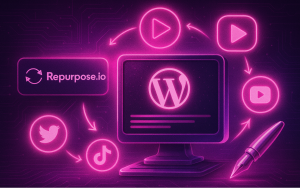Key Takeaways
- Distributing video content across multiple platforms increases your reach by 300% compared to single-platform strategies.
- Platform-specific optimization is crucial—what works on YouTube won’t necessarily work on TikTok or Instagram.
- Email marketing with video content generates more engagement than text-only emails.
- Strategic cross-promotion between owned and external channels creates a content ecosystem that drives continuous traffic.
- AmpCast automates video content repurposing by transforming a single topic into 8 content formats and distributes them to 300+ sites, saving you countless hours of manual content creation while maximizing reach.
Video Distribution Platforms That Drive Results
Effective video distribution requires a multi-platform approach customized to your specific audience and goals.
YouTube remains the powerhouse for searchable, evergreen content, while platforms like TikTok excel at viral, short-form videos. Email distribution creates direct connections with engaged audiences, and your website serves as your content hub where you control the user experience completely.
How AmpiFire Works:
- Research & Target: Find high-demand topics your buyers search for
- Create & Repurpose: AmpiFire’s AmpCastAI generates news articles, blogs, videos, podcasts, infographics, slideshows, and social posts
- Distribute & Amplify: Auto-publish to 300+ sites including Google News, YouTube, Spotify, and major news networks
Get more traffic from people who want to buy your stuff, and powerful “As Seen On” trust badges for your site.
Do It Yourself (with AI), Done For You Content, & 100% Managed Organic Growth options available.
Grow Your Free Traffic From Everywhere
7 Best Strategies to Distribute Video Content
1. Optimize Social Media Video Sharing
Social media platforms heavily favor native content in their algorithms, making direct video uploads essential for maximizing reach and engagement.
When you upload videos directly to each platform rather than sharing external links, you’re working with the algorithm instead of against it, resulting in significantly higher visibility and interaction rates.
Platform-Specific Video Specs
Each social platform has unique video specifications that directly impact performance. Instagram Reels perform best in 9:16 ratio at 1080×1920 pixels, while LinkedIn favors 1:1 square formats for in-feed videos.
Facebook rewards longer watch times with greater reach, making 2–3 minute videos optimal, whereas TikTok’s algorithm prioritizes completion rates, making 15–30 second videos more effective.
Video resolution requirements vary significantly across platforms. YouTube prefers 1080p minimum (with 4K gaining priority in search results), while most social platforms compress videos heavily, making ultra-high resolution less impactful.
Optimizing file size while maintaining quality provides the best balance for most distribution channels.
Best Posting Times
Analysis reveals that posting timing significantly impacts initial video performance, with morning fetching the highest average reach on Facebook. While there are general posting guidelines, your specific audience may have different peak engagement times.
We recommend testing various posting times and analyzing performance data to identify your optimal distribution schedule.
2. Use Video Email Marketing
Email remains one of the most effective distribution channels for video content, with click rates averaging 65% higher when the word “video” appears in the subject line.
Rather than sending video files to all your clients or contacts, segmenting your email list based on viewer interests and previous engagement patterns allows for targeted video distribution.
Embedding Videos in Emails
Most email clients don’t support direct video playback within emails, so effective embedding requires workarounds. Use animated GIFs created from video clips with play button overlays that link to landing pages with the full video. This approach can result in higher click-through rates compared to static thumbnail images.
When embedding videos in email campaigns, include the video timestamp (e.g., “2:14”) in the email copy to set expectations for time commitment. By explicitly mentioning shorter video lengths (under 5 minutes) recipients are more likely to commit to watching when they know the time investment required.
Subject Line Tactics
Subject lines that include both the recipient’s name and video reference can make your email more appealing to your audience than generic subject lines. The email preview text should reinforce the video content value proposition to maximize opens and engagement.
In fact, our own analysis found that adding content type teasers in subject lines, especially [VIDEO], significantly increases email open rates compared to other bracket indicators like [TRAINING] or [UPDATE].
3. Host Videos on Your Website
Strategic video placement on relevant pages on your website can increase visitor time-on-site and reduce bounce rates. We recommend hosting key conversion-focused videos directly on your site while using platforms like YouTube for broader discovery content.
Video Placement Tips
Above-the-fold videos capture immediate attention, often will get higher play rates than videos placed lower on pages. For landing pages, position videos after establishing the core problem but before presenting your solution to create maximum impact at the decision point.
Use behavioral triggers to determine video placement. Heat mapping tools reveal where visitors focus their attention on specific pages, allowing you to position videos in naturally high-engagement zones.
Load Time Considerations
Video hosting can impact site performance, which directly affects user experience. Self-hosted videos provide maximum control but can slow page loading if not properly optimized.
You can use a content delivery network (CDN) for video delivery or implement lazy loading to delay video loading until the user scrolls near the video location.
Consider implementing adaptive bitrate streaming that adjusts video quality based on the viewer’s connection speed. This approach ensures videos play smoothly across all devices and connection types while minimizing buffering that can lead to abandonment.
4. Use YouTube’s Full Potential
YouTube remains the second-largest search engine globally, making it essential for discoverability.
The platform’s algorithm rewards watch time above all other metrics, so creating content that holds viewer attention generates exponentially more distribution through recommendations. Aside from quality content there are other ways to optimize your videos distribution on YouTube.
Channel Optimization
Your YouTube channel architecture significantly impacts content discovery and audience retention. Organize videos into themed playlists that encourage sequential viewing, which increases overall watch time and improves algorithmic distribution.
Channel branding elements like custom thumbnails, channel trailers, and featured videos create a cohesive viewer experience that encourages subscription and return visits.
End Screen Strategy
End screens provide crucial distribution opportunities within your own content ecosystem. Implement end screens that direct viewers to related content based on the viewing journey, not just your newest videos.
Test various end screen formats to determine which generates the highest continuation rates for your specific audience. Options include featuring specific videos, promoting playlists, encouraging channel subscriptions, or highlighting your website. The most effective approach typically combines a specific next-video recommendation with a broader playlist option.
5. Cross-Promote Through Partner Channels
Cross-promotion works best when the value exchange is clear and equitable. Rather than simply asking others to share your content, create co-branded videos that serve both audiences or develop content that specifically addresses partner audience pain points.
This approach results in more enthusiastic promotion and stronger audience transition.
Finding Collaboration Partners
Identify potential partners by analyzing audience overlap and complementary (not competing) offerings. The ideal partners serve similar audiences but with different products or at different stages of the customer journey.
Start partnership outreach with smaller, accessible creators before approaching larger channels. Establishing a track record of successful collaborations builds credibility for approaching high-reach partners.
Content Sharing Agreements
Formalize cross-promotion arrangements with clear agreements that specify content types, promotion schedules, and performance expectations. Written agreements prevent misunderstandings and ensure both parties receive appropriate value. For significant partnerships, consider revenue-sharing models based on conversions rather than just exposure.
Track partner-driven traffic and conversions using dedicated landing pages or UTM parameters to measure ROI. This data-driven approach allows you to identify your most valuable distribution partnerships and helps you focus on relationships that deliver measurable results.
6. Create Video Content Hubs
Developing a content hub strategy requires mapping the viewer journey from awareness through consideration to decision. Create video collections that address each stage to allow viewers to self-select content based on their current needs and interests.
This approach not only improves user experience but also significantly increases content consumption per visitor.
Organizing By Topic
Topic clusters organize related videos into intuitive groupings that make content discovery seamless. Each cluster should include a cornerstone piece that provides a comprehensive overview, supported by specific videos that dive deeper into subtopics. This structure mimics natural learning patterns and keeps viewers engaged longer.
Implementation can occur on your website, YouTube channel, or even within playlist structures on various platforms. The key is consistent organization across all distribution points, creating familiar navigation patterns that reduce friction in the viewing experience.
User Experience Design
Design your content hubs with user experience as the primary consideration. Implement clear navigation, consistent thumbnails, descriptive titles, and progress tracking to help viewers easily find and resume content.
Mobile optimization is particularly crucial, as 75% of video consumption now occurs on mobile devices.
7. Using AI Distribution Strategically
AI-powered content distribution transforms video marketing from reactive to predictive, enabling data-driven decisions that maximize content performance across all channels.
Machine learning algorithms analyze viewer behavior patterns, engagement metrics, and content characteristics to identify optimal distribution timing, platform selection, and audience targeting strategies.
Automated Distribution Workflows
AI streamlines distribution processes through intelligent automation that adapts to platform requirements and audience preferences. Automated systems can optimize video formats, thumbnails, and descriptions for each platform while maintaining brand consistency across all channels.
These workflows remove manual platform-specific adaptations while ensuring content meets each platform’s unique optimization requirements.
Amplify Your Video Distribution with Ampcast
Video distribution success requires consistent content creation and strategic platform placement. But manually managing multiple video formats and channels demands enormous time and resources.
AmpiFire revolutionizes this process by using AI to automatically transform your video topics into multi-channel content campaigns that reach audiences across every major platform.
Our AmpCast platform takes any topic and automatically creates 8 different content formats: news articles, blog posts, interview podcasts, videos, video shorts, infographics, slideshows, social posts.
The platform then ensures your video content reaches audiences across major video platforms including YouTube, Vimeo, TikTok, Instagram Reels, Facebook Video, and dozens of other video-focused sites within our 300+ distribution network. This reduces the tactical work of writing, formatting, and publishing content across platforms.
One of our clients saw an incredible increase in website traffic brought by our amp campaigns. After experiencing stagnant website traffic for 6 months, our content marketing campaigns successfully reestablished organic traffic with a 31% growth in just three months.
This dramatic improvement demonstrates how strategic content distribution transforms business growth. Our approach captures attention in today’s visual-dominant digital landscape while building authority across platforms where your customers actively consume video content.
Instead of managing complex video production, editing, platform-specific formatting, and distribution tasks, you can concentrate on what you do best for your business.
Frequently Asked Questions (FAQ)
What video length works best for different platforms?
Optimal video length varies significantly by platform:
- YouTube: 7–15 minutes for most topics, with educational content extending to 20+ minutes
- Instagram: Reels is 15–30 seconds while IGTV is 2–5 minutes
- TikTok: 15–60 seconds
- LinkedIn: 45–90 seconds
- Facebook: 1–3 minutes
However, content quality and viewer retention ultimately matter more than arbitrary length targets.
Should I use the same video across all channels?
Using identical videos across all platforms significantly reduces effectiveness. Each platform has unique aspect ratios, audience expectations, and algorithmic preferences that affect performance.
Create a primary video asset, then adapt it with platform-specific introductions, aspect ratios, pacing, and calls-to-action. This way, you keep your message consistent while tweaking it to work best on each platform.
How can I distribute videos with a minimal budget?
Low-budget distribution should focus on maximizing organic reach through strategic platform selection and community building.
Start by identifying where your target audience already gathers and focus your efforts there rather than spreading resources across all platforms.
Consistency on 2–3 platforms generates better results than sporadic posting everywhere. Use existing email lists, business partners, and community connections for initial distribution.
What’s the best way to repurpose existing video content?
Strategic repurposing extracts maximum value from your video assets. For long-form videos, create thematic clips highlighting key points that can stand alone on social platforms.
Transform video insights into complementary content formats like blog posts, infographics, and podcasts that refer back to the original video.
Updating older evergreen content with new introductions or data refreshes can revitalize performance without creating entirely new videos.
Can AmpiFire help me distribute video content without creating separate versions for each platform?
Yes, AmpiFire’s AmpCast technology takes your video topic and automatically creates 8 different content formats optimized for various platforms.
You provide the topic once, and our AI generates news articles for news sites, podcasts for Spotify and Apple Podcasts, infographics for Pinterest, and videos for YouTube, Instagram, Tiktok—all distributed to 300+ sites automatically.
This takes away the need to manually create platform-specific versions while ensuring each format meets the unique requirements of its destination platform.
Author
-
CEO and Co-Founder at AmpiFire. Book a call with the team by clicking the link below.
Related Posts

How to Distribute Sports Content: Strategies & Examples
See proven strategies to distribute sports content across multiple platforms. Learn from successful examples and maximize your sports content reach.

5 Ways to Distribute Your Infographics: Best Practices
Learn proven strategies to distribute infographics across multiple platforms. Increase reach with AmpiFire's automated system.
How to Distribute Healthcare Content: Strategies & Examples
Learn 3 proven strategies to distribute healthcare content effectively. Read about compliant methods to reach patients, build trust, and expand…

How to Distribute Financial Content: Tips & Examples
Learn effective financial content distribution strategies. Reach more investors and finance bros across multiple channels with compliance-safe methods.

Repurpose.io Features & Pricing: Can This Tool Distribute Your Content Everywhere?
Learn Repurpose.io's automated content distribution features, pricing plans, and if this tool truly helps you reach every platform with one…

Repurpose Video Content Into AI Blog Posts, Social Media & Multiple Formats
Learn how to repurpose long videos across LinkedIn, blogs, Twitter (X), Facebook, TikTok, Reels, and YouTube using AI to maximize…










